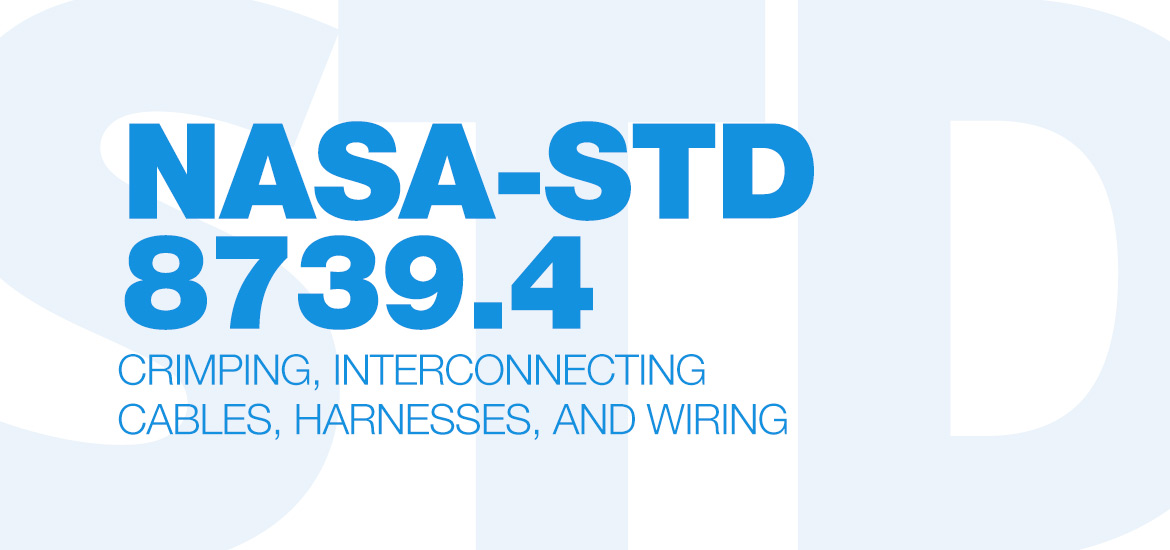Updates to Crimping, Interconnecting Cables, Harnesses, and Wiring Standard Published
August 25, 2016
4-minute read

Update: This article was updated to reflect that Alvin Boutte is now the Point of Contact for questions regarding Workmanship Standards.
NASA-STD-8739.4A, Crimping, Interconnecting Cables, Harnesses, and Wiring was updated and released on June 30, 2016. The revised standard, effective for five years, includes significant technical updates and corrections. This update was one of three recently publish standard updates, which included NASA-STD-8739.1B, Workmanship Standard for Polymeric Application on Electronic Assemblies and NASA-STD-8739.6A, Implementation Requirements for NASA Workmanship Standards.
The following is a brief summary of the changes, but to learn more, review the Document History Log in the front of the standard document:
- Generic requirements that were found in all NASA Workmanship standards were moved to NASA-STD-8739.6. Examples include requirements traceability in suppliers’ procedures, use of alternate standards, use of nonstandard configurations and laboratory environment conditions.
- Definitions found in NASA-STD-8709.22, Safety & Mission Assurance Acronyms, Abbreviations, & Definitions, were removed. The definitions found in NASA-STD-8709.22 for the terms “rework” and “repair” are now applicable.
- The requirement for a magnetic survey for uses of high-strength copper alloy wire was removed. Project design and Electromagnetic Interference/Electromagnetic Compatibility requirements are used for wire conductor selections.
- A requirement was added to specify wire dress and lay in engineering documentation (e.g., production drawings).
- Launch vehicles are now included in applications where spiral-wrapped sleeving is prohibited.
- Contradictory rules were removed regarding crimp pull test failures and ambiguous and duplicate information for crimp pull acceptance criteria. It is no longer required to record the type of break.
- Requirements were removed that were related to crimp process development. Requirements related to pre- and post-production process verification pull testing were retained.
- It is now required that instructions are provided to operators when connector subcomponents are to be removed during cable assembly (e.g., grommets and gaskets that will outgass).
- Soldering requirements were synchronized to J-STD-001FS and no longer point to NASA-STD-8739.3.
- The requirement to inspect captured solder cup interconnects was extended to all connectors with captured solder cup contacts rather than limiting it to hermetic connectors only.
- Process controls are now required to ensure full solder fill of solder contacts. This has been a long-term issue with coaxial connectors.
- Engineering documentation must now state applicable torque values.
- A requirement was added for moisturization bake-out following cleaning for cables with expanded foam insulation.
- Aqueous cleaning on silver-plated copper wire is prohibited.
- The requirement to protect finished harnesses with bubble wrap specifically was removed. This requirement was redundant with generic requirements already imposed by NASA-STD-8739.6 for protection of mission hardware and is an unnecessarily specific implementation.
- Packaging of connector and wiring assemblies containing fluoropolymer insulation must be vented to avoid fluorine-driven corrosion of connector and contact surfaces.
Reviewing Feedback and Updating the Standard
Two-hundred and eighty comments were received for the A revision of this standard. The acceptance rate for the comments received was 79 percent. Of the comments that were not accepted, 42 percent related to rewording or adding to generic language or requirements that were moved to NASA-STD-8739.6. Some comments that were not accepted required or requested specific implementation of materials or processes with the unintended consequence of excluding other viable solutions.
Several comments arose from a misunderstanding about how the standard Dielectric Withstanding Voltage (DWV) test is performed. These comments suggested that the high test voltage may be damaging and exceed the connector voltage rating. DWV testing uses a relatively high voltage for a very short time to discover minute defects or drive latent defects to early life failure either in the connector insulator insert (that holds the contacts apart from each other and provides electrical isolation between them) or in the wire insulation. These tests also are invoked at the piece part level (i.e., on connectors and on wire) and are well-established to be nondestructive to high quality, defect-free connectors and wire and are effective quality screening tools.
Several comments were not accepted at this time as they require greater study and coordination to resolve. These comments concerned
- Avoiding certain types of connector covers that can interfere with contacts or shell mating surfaces
- Relief from using 3D form boards/fixturing during harness production
- Providing a blanket exemption to all design and material selection requirements for certified aircraft that is maintained in accordance with the military technical order or other maintenance manual
- Adding requirements for uninsulated terminal lugs
- Making this standard consistent with Military AS50881 and IPC/WHMA-A-620B-S for wire insulation types and minimum bend radii
Requests were made for including crimp pull force values for additional contact sizes and procedural guidance for performing crimp pull testing when multiple sized wires are used in a single crimp contact. The NASA Workmanship Program has sponsored laboratory testing to address this request.
Questions about the standard or suggestions for improvements may be addressed to Alvin Boutte.